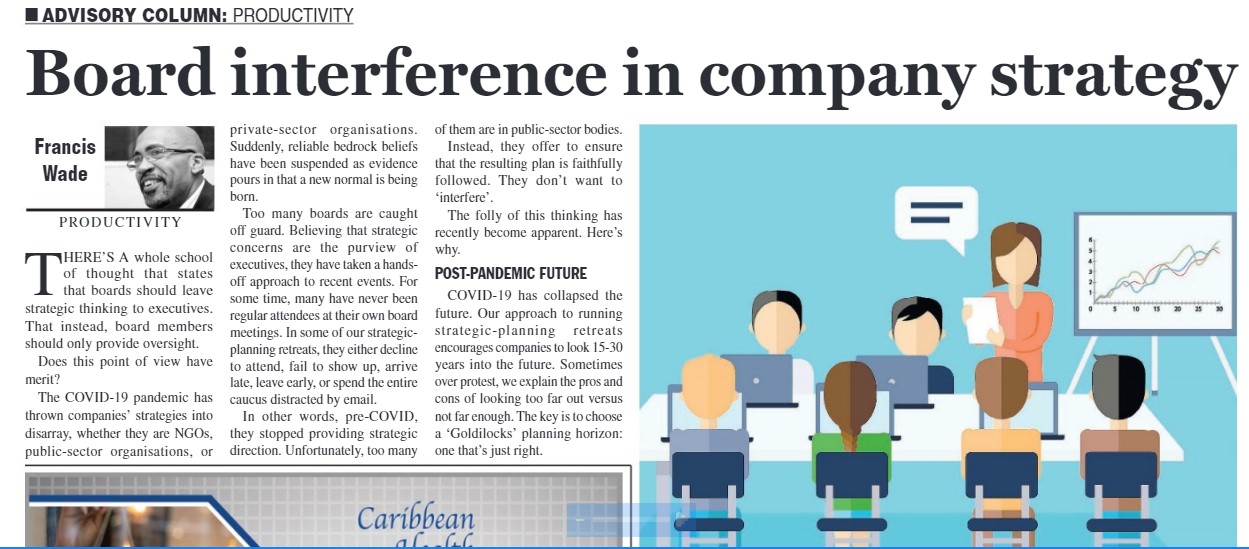There’s a whole school of thought which states that boards should leave strategic thinking to executives. Instead, board members should only provide oversight. Does this point of view have merit?
The COVID pandemic has thrown companies’ strategies in disarray, whether they are NGO’s, public or private sector organizations. Suddenly, reliable bedrock beliefs have been suspended as evidence pours in that a new normal is being born.
Too many boards are caught off-guard. Believing that strategic concerns are the purview of executives, they have taken a hands-off approach to recent events. For some time, many have never been regular attendees at their own board meetings. In some of our strategic planning retreats, they either decline to attend, fail to show up, arrive late, leave early, or spend the entire caucus distracted by email.
In other words, pre-COVID, they stopped providing strategic direction. Unfortunately, too many of them are public sector bodies.
Instead, they offer to ensure that the resulting plan is faithfully followed. They don’t want to “interfere.”
The folly of this thinking has recently become apparent. Here’s why.
1) COVID has collapsed the future
Our approach to running strategic planning retreats encourages companies to look 15-30 years into the future. Sometimes over protest, we explain the pros and cons of looking too far out, vs. not far enough. The key is to choose a “Goldilocks” planning horizon: one that’s just right.
Pity the companies which have chosen a horizon which is too short. Why? They’ll have to restart their planning process.
The truth is that organizations who chose long horizons already planned for the changes COVID has made urgent. The only difference is that the pandemic has brought the future closer: collapsing it. All they need to do is change the timeline.
However, a company with a too-short strategy would miss the ball entirely. They’d have to rethink everything simply because of a tactical error in forming their plan. This is where board members make a difference: they are usually the ones pushing for longer horizons. Their absence makes this mistake more likely to occur.
2) Fresh New Eyes Are Necessary at the Top
The pandemic has shown us what it’s like to be completely blindsided. However, it should also predict which individuals will rebound first.
Those who are younger and newer to the organization have an advantage. Just observe how they adapt themselves to the use of an app such as Zoom which has assumed a central role in most companies.
Contrast this reality with some leaders. I once worked with the head of communications of a large company who hid a big secret – he didn’t know how to use Powerpoint. How he got to that position without picking up a basic tool of the trade remained a mystery.
Boards need to challenge executives to keep developing themselves. They should also welcome fresher, younger eyes into their ranks to prevent companies from becoming stale.
As such, boards need to properly estimate how in touch they are. Unfortunately, many fail to include digital strategists in the boardroom so it becomes difficult to provide proper guidance on the most challenging issues of the day.
3) Bringing Back the Best Employees
Today, CEOs’ are looking around the office, shaking their heads and wondering: “Why did I ever think we needed so many people?” Now, their suspicions have been confirmed: when some employees stayed home, and contributed little, they weren’t missed. In other words, their absence wasn’t a problem.
Can organizations simply cherry-pick the best employees, pay them a bit more and let go of the rest?
I predict that the new normal will force them to do so, within the limits of the labour laws. Outsiders may complain that they are just being greedy. However, board members may
point to the need to survive the first worldwide disruption in business to occur in our lifetime.
They are more likely to switch to a more digitally-savvy workforce that can manage itself without being watched. Individual salaries may rise by so doing, but the number of total employees may fall. Overall productivity should increase even as payroll costs are cut.
Boards should also prevent executives from rushing to return to a pre-COVID status quo which wouldn’t be sustainable. They should have a well-established point of view developed from seeing the inside operations of other companies.
These are trying times, and the cozy collegiality of the board room must give way to the committed few who are willing to take a stand in an effort to keep companies afloat.
Organizations need their boards to jump into the fray wholeheartedly. They must intervene to make the best of a messy situation and play their part in crafting a strategy that serves all concerned.

